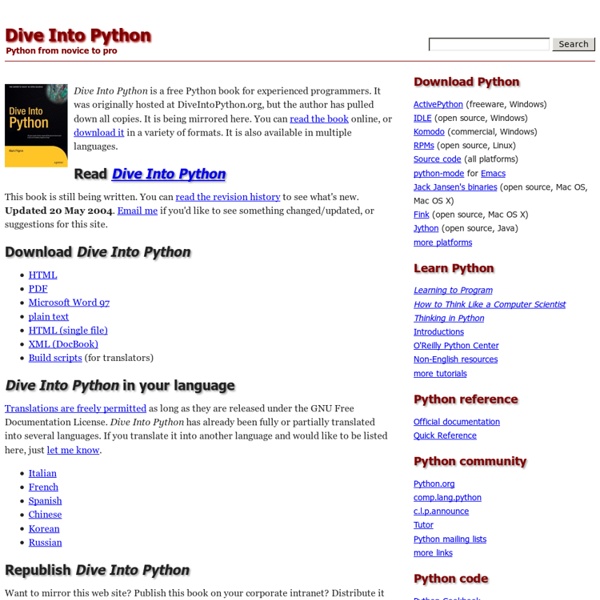



http://www.diveintopython.net/
BeginnersGuide/Programmers Please Note This is a Wiki page. Users with edit rights can edit it. You are therefore free to (in fact, encouraged to) add details of material that other Python users will find useful. Code Like a Pythonista: Idiomatic Python In this interactive tutorial, we'll cover many essential Python idioms and techniques in depth, adding immediately useful tools to your belt. There are 3 versions of this presentation: ©2006-2008, licensed under a Creative Commons Attribution/Share-Alike (BY-SA) license. Graphics with Matplotlib Matplotlib is a large and sophisticated graphics package for Python written in object oriented style. However, a layer built on top of this basic structure called pyplot accesses the underlying package using function calls. We describe a simple but useful subset of pyplot here.
Python Resources Skip to this view's content Please enter your e-mail address below, and we will e-mail instructions for setting a new password. Help Think Python: How to Think Like a Computer Scientist How to Think Like a Computer Scientist by Allen B. Downey BeginnersGuide New to programming? Python is free and easy to learn if you know where to start! This guide will help you to get started quickly. Chinese Translation New to Python? Solving Every Sudoku Puzzle by Peter Norvig In this essay I tackle the problem of solving every Sudoku puzzle. It turns out to be quite easy (about one page of code for the main idea and two pages for embellishments) using two ideas: constraint propagation and search. Sudoku Notation and Preliminary Notions First we have to agree on some notation.
Second Try: Sentiment Analysis in Python : Andy Bromberg Introduction After my first experiments with using R for sentiment analysis, I started talking with a friend here at school about my work. Jackson and I decided that we’d like to give it a better shot and really try to get some meaningful results. After a lot of research, we decided to shift languages to Python (even though we both know R). We made this shift because Python has a number of very useful libraries for text processing and sentiment analysis, plus it’s easy to code in.
For the Single Founder Who Can’t Code Editor’s note: This is a guest post by Mick Hagen (@mickhagen), founder and CEO of Undrip. He was previously the founder of Zinch which was acquired by Chegg last year. He made headlines in the Fall with his rap campaign – an unorthodox approach to fundraising. You can learn more about him at MickHagen.com. TkInter Tkinter is Python's de-facto standard GUI (Graphical User Interface) package. It is a thin object-oriented layer on top of Tcl/Tk. Tkinter is not the only GuiProgramming toolkit for Python. It is however the most commonly used one. CameronLaird calls the yearly decision to keep TkInter "one of the minor traditions of the Python world."
Python Examples On these pages, I have collected a bit of information about the Python programming language, along with a bunch of examples. These might be useful if you want to see some of the features without actually learning the language itself. You don't have to read through all of this in order. Just pick the pages which look most interesting to you.
by far the best python tutorial for programmers that already know another language. by hjwp Jan 31